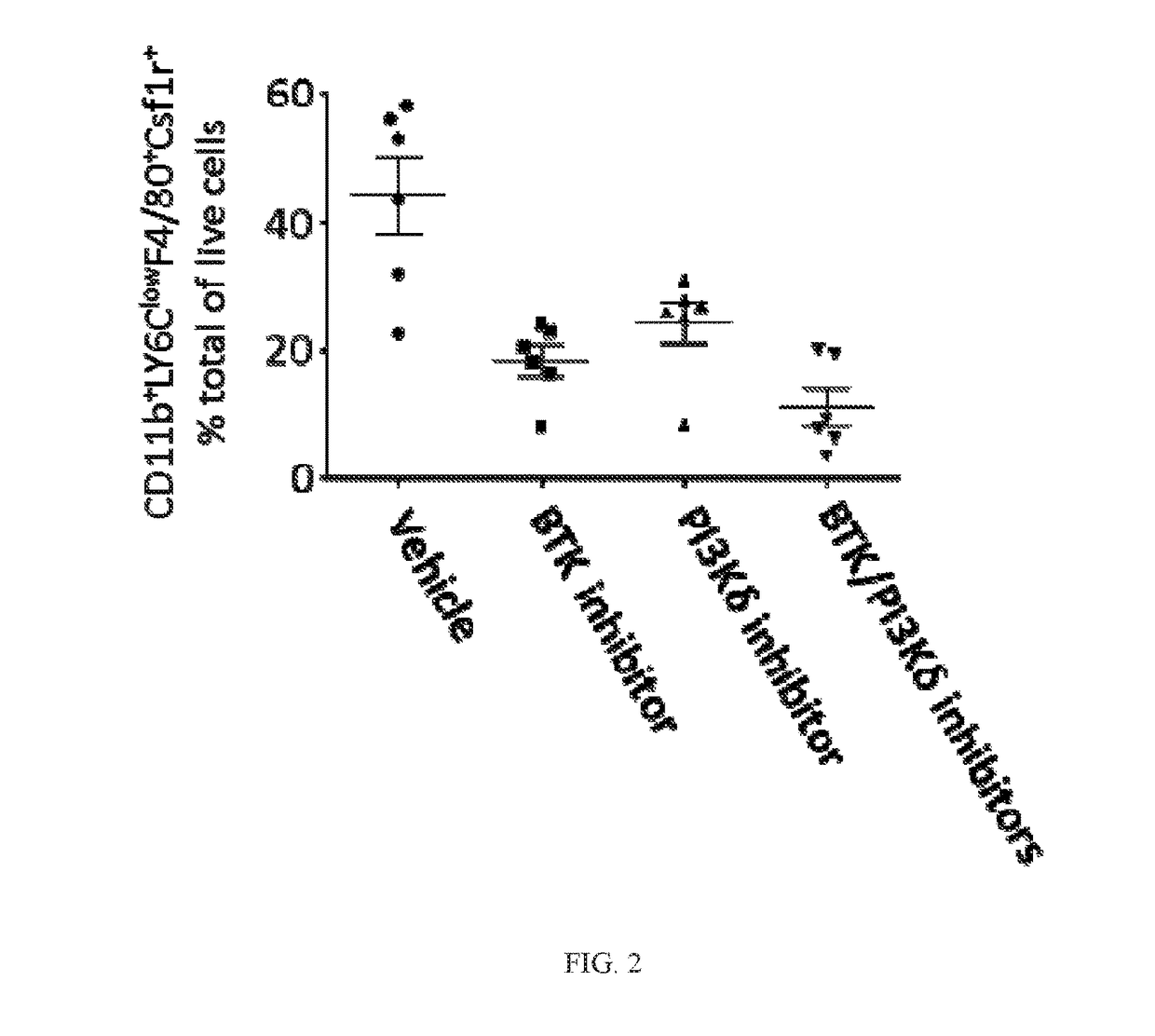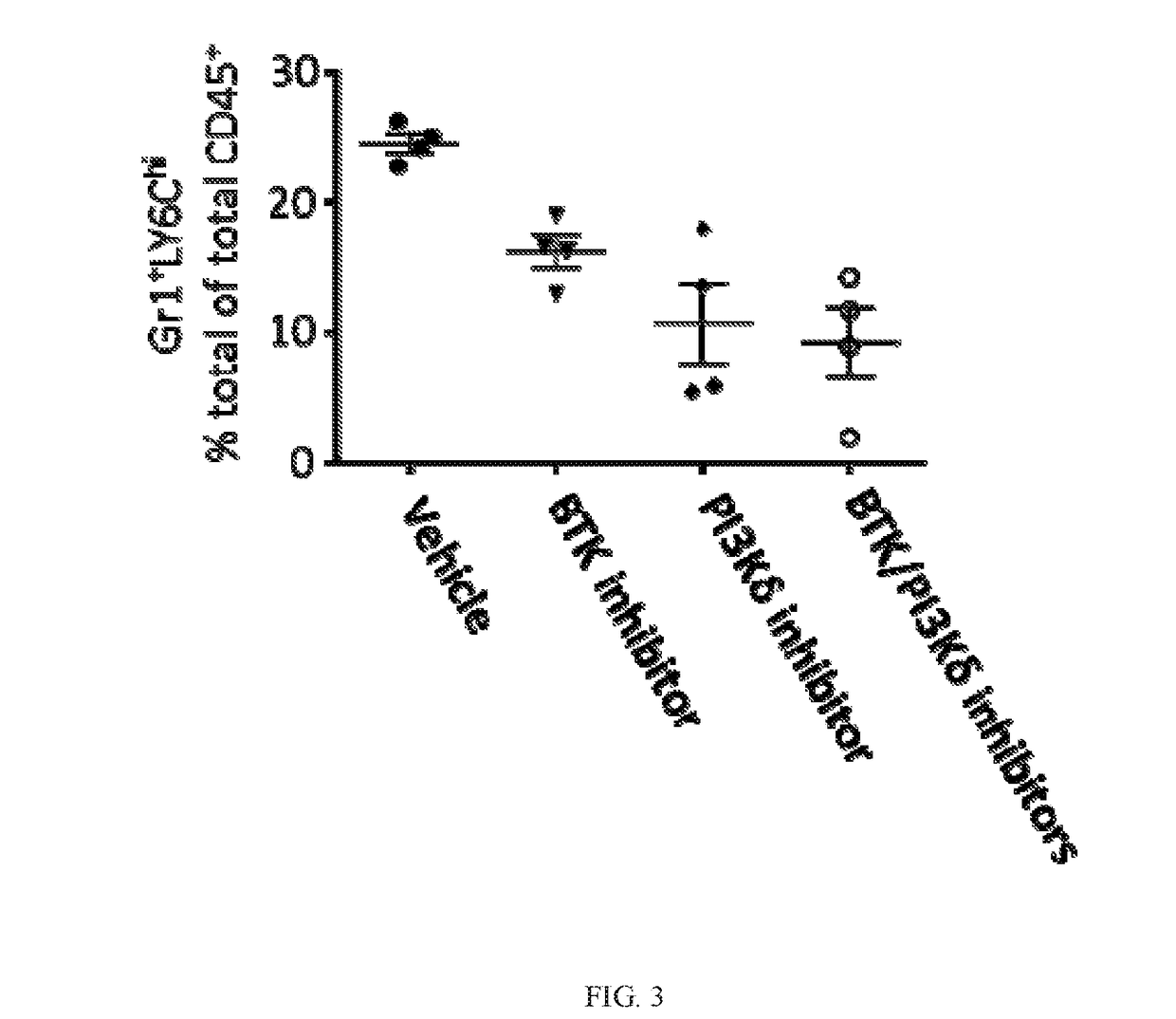BTK Inhibitors to Treat Solid Tumors Through Modulation of the Tumor Microenvironment
a tumor microenvironment and inhibitor technology, applied in the direction of pharmaceutical active ingredients, organic active ingredients, drug compositions, etc., can solve the problems that the protective effect of the tumor microenvironment cannot be overcome by chemo, and the treatment of the tumor cells themselves has also proved insufficient to overcome the protective effect of the microenvironment, so as to increase the treg development
- Summary
- Abstract
- Description
- Claims
- Application Information
AI Technical Summary
Benefits of technology
Problems solved by technology
Method used
Image
Examples
example 1
itory Effects on Solid Tumor Microenvironment in an Orthotopic
Pancreatic Cancer Model
[0651]An orthotopic pancreatic cancer model was used to investigate the therapeutic efficacy of the BTK inhibitor of Formula (II) a through treatment of the solid tumor microenvironment. Mice were dosed orally with 15 mg / kg of Formula (II), 15 mg / kg of a phosphoinositide 3-kinase δ (PI3K-δ) inhibitor (also referred to as “p110d”), or a combination of 15 mg / kg of both drugs.
[0652]Cell line derived from KrasG12D;Trp53R172H;Pdx1-Cre (KPC) mice were orthotopically implanted into the head of the pancreas after 35 passages. Based on the mice background from where the cell lines were generated, 1×106 cells were injected in C57BL / 6 mice. Throughout the experiment, animals were provided with food and water ad libitum and subjected to a 12-h dark / light cycle. Animal studies were performed in accordance with the U.S. Public Health Service “Guidelines for the Care and Use of Laboratory Animals” (IACUC). After e...
example 2
itory Effects on Solid Tumor Microenvironment in an Ovarian Cancer Model
[0655]The ID8 syngeneic orthotropic ovarian cancer murine model was used to investigate the therapeutic efficacy of the BTK inhibitor of Formula (II) through treatment of the solid tumor microenvironment. Human ovarian cancer models, including the ID8 syngeneic orthotropic ovarian cancer model and other animal models, are described in Fong and Kakar, J. Ovarian Res. 2009, 2, 12; Greenaway, et al., Gynecol. Oncol. 2008, 108, 385-94; Urzua et al., Tumour Biol. 2005, 26, 236-44; Janat-Amsbury, et al., Anticancer Res. 2006, 26, 3223-28; Janat-Amsbury, et al., Anticancer Res. 2006, 26, 2785-89. Animals were treated with vehicle or Formula (II), 15 mg / kg / BID given orally. The results of the study are shown in FIG. 5, FIG. 6, FIG. 7, FIG. 8, FIG. 9, FIG. 10, FIG. 11, and FIG. 12.
[0656]FIG. 5 and FIG. 6 demonstrate that the BTK inhibitor of Formula (II) impairs ID8 ovarian cancer growth in the ID8 syngeneic murine model...
example 3
itory Effects on Solid Tumor Microenvironment Through Modulation of Tumor-Infiltrating MDSCs and TAMs
[0658]A study was performed to observe potential reduction in tumor burden through modulation of tumor infiltrating MDSCs and TAMs using the BTK inhibitor of Formula (II) and / or gemcitabine (“Gem”). In this study, KPC derived mouse pancreatic cancer cells (KrasG12D;Trp53R172H;Pdx1-Cre) were injected into the pancreases. Animals were treated with (1) vehicle; (2) Formula (II), 15 mg / kg / BID given orally; (3) gemcitabine 15 mg / kg intravenous (IV) administered every 4 days for 3 injections; or (4) Formula (II), 15 mg / kg / BID given orally with together with gemcitabine, 15 mg / kg IV administered every 4 days for 3 injections.
[0659]Single cell suspensions from tumor samples. Mouse tumor tissue was collected and stored in PBS / 0.1% soybean trypsin inhibitor prior to enzymatic dissociation. Samples were finely minced with a scissors and mouse tissue was transferred into DMEM containing 1.0 mg / m...
PUM
 Login to View More
Login to View More Abstract
Description
Claims
Application Information
 Login to View More
Login to View More - R&D
- Intellectual Property
- Life Sciences
- Materials
- Tech Scout
- Unparalleled Data Quality
- Higher Quality Content
- 60% Fewer Hallucinations
Browse by: Latest US Patents, China's latest patents, Technical Efficacy Thesaurus, Application Domain, Technology Topic, Popular Technical Reports.
© 2025 PatSnap. All rights reserved.Legal|Privacy policy|Modern Slavery Act Transparency Statement|Sitemap|About US| Contact US: help@patsnap.com



